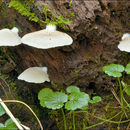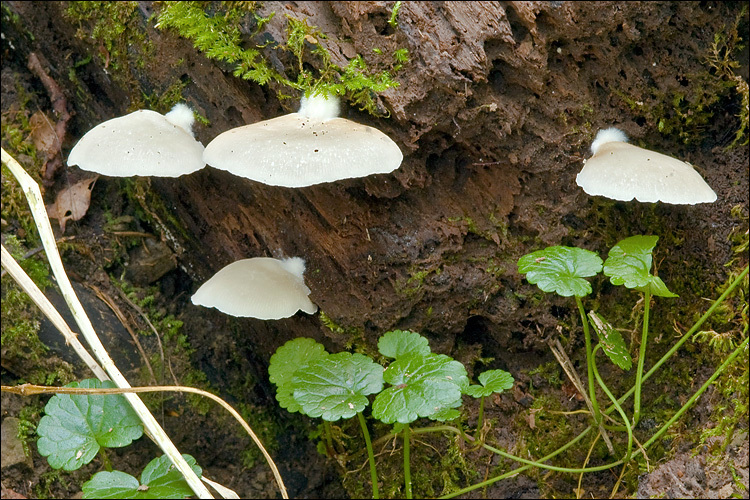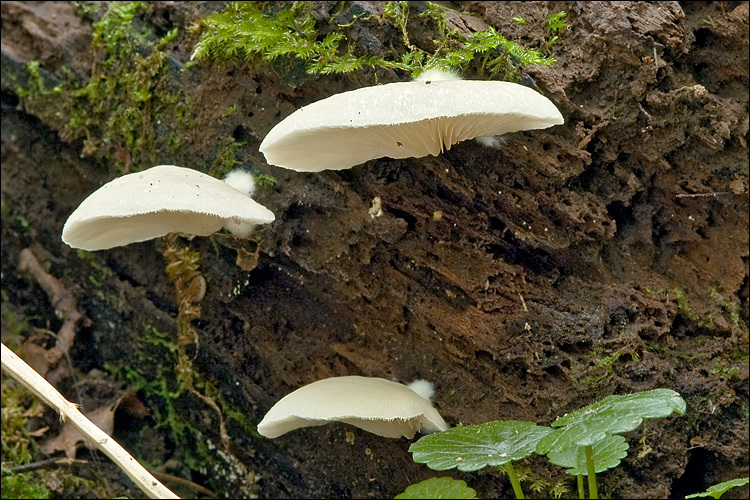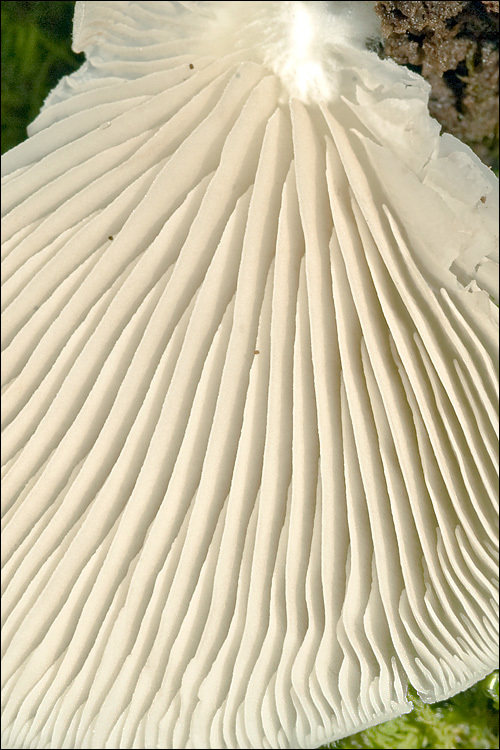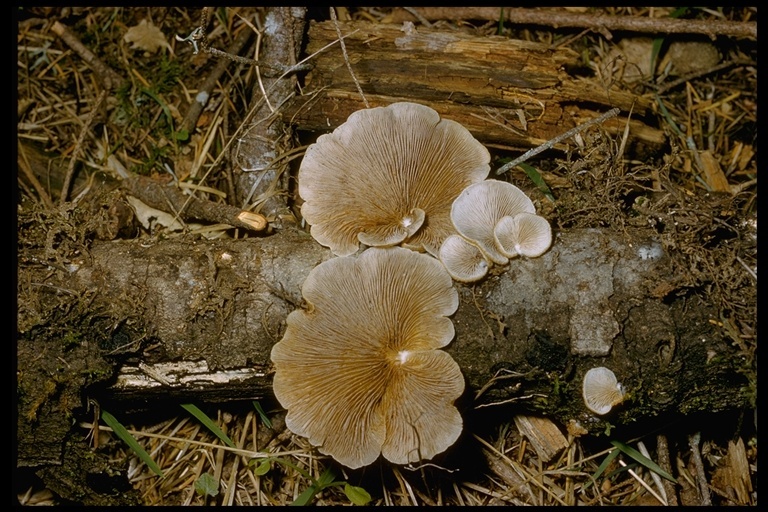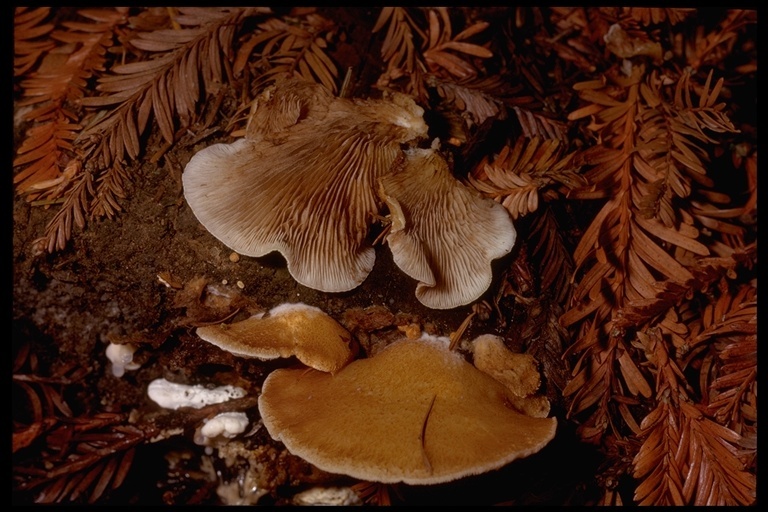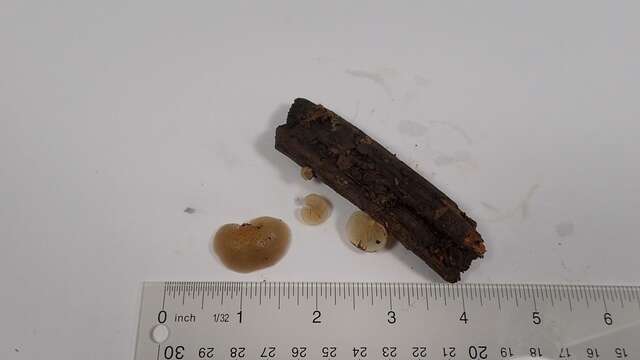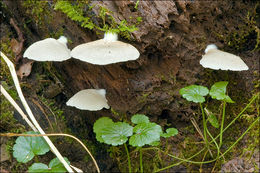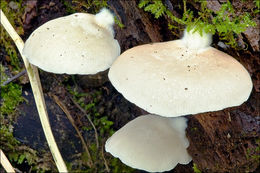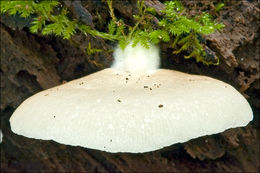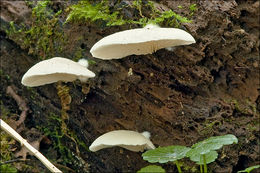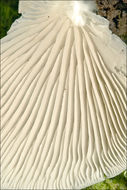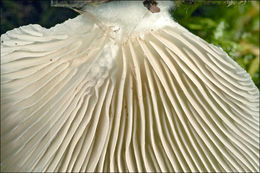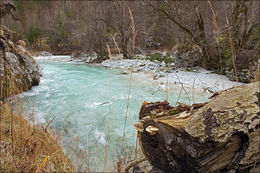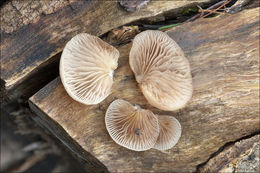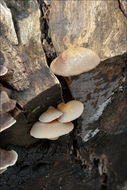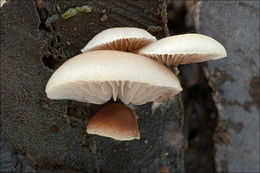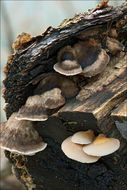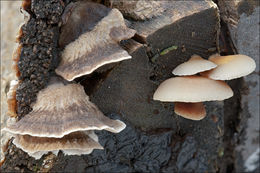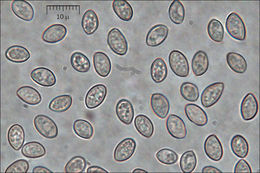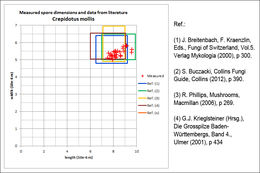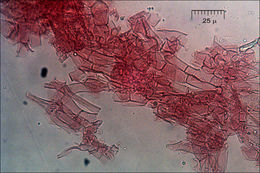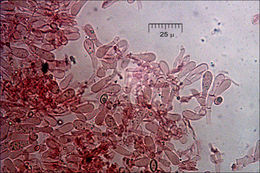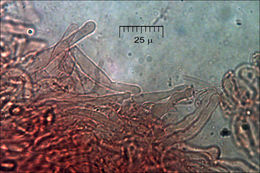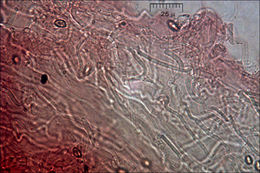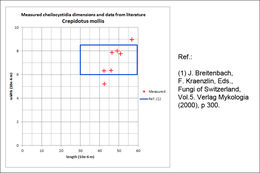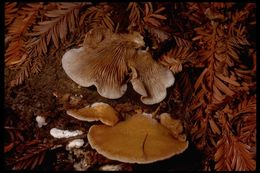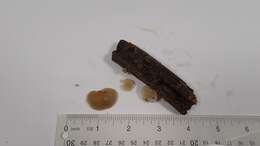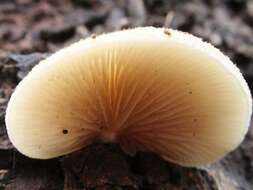-
Slo.: zdrizasta postranica - Habitat: Mixed woodland, cretaceous clastic rock (flysh), protected from direct rain by tree canopies, in full shade, humid place, average precipitations ~3.000 mm/year, average temperature 8-10 deg C, elevation 435 m (1.450 feet), alpine phytogeographical region. - Substratum: Debarked, heavily rotten log of a deciduous tree, probably Acer sp., Fraxinus excelsior or less probably Quercus. - Comment: Has a distinct gelatinous layer on upper side of pileus. - Ref.: (1) Personal communication with Mr. Anton Poler, Slovenia. (2) A. Poler, Ed., Seznam Gliv Slovenie (in Slovene) (Check list of mushrooms of Slovenia), Assoc. of Mycological Societies of Slovenia (1998), p 22. (3) M.Bon, Pareys Buch der Pilze, Kosmos (2005), p 244. (4) D.Arora, Mushrooms Demystified, Ten Speed Press, Berkeley (1986), p 406. (5) http://www.grzyby.pl/gatunki/Crepidotus_mollis.htm
-
Slo.: zdrizasta postranica - Habitat: Mixed woodland, cretaceous clastic rock (flysh), protected from direct rain by tree canopies, in full shade, humid place, average precipitations ~3.000 mm/year, average temperature 8-10 deg C, elevation 435 m (1.450 feet), alpine phytogeographical region. - Substratum: Debarked, heavily rotten log of a deciduous tree, probably Acer sp., Fraxinus excelsior or less probably Quercus. - Comment: Has a distinct gelatinous layer on upper side of pileus. - Ref.: (1) Personal communication with Mr. Anton Poler, Slovenia. (2) A. Poler, Ed., Seznam Gliv Slovenie (in Slovene) (Check list of mushrooms of Slovenia), Assoc. of Mycological Societies of Slovenia (1998), p 22. (3) M.Bon, Pareys Buch der Pilze, Kosmos (2005), p 244. (4) D.Arora, Mushrooms Demystified, Ten Speed Press, Berkeley (1986), p 406. (5) http://www.grzyby.pl/gatunki/Crepidotus_mollis.htm
-
Slo.: zdrizasta postranica - Habitat: Mixed woodland, cretaceous clastic rock (flysh), protected from direct rain by tree canopies, in full shade, humid place, average precipitations ~3.000 mm/year, average temperature 8-10 deg C, elevation 435 m (1.450 feet), alpine phytogeographical region. - Substratum: Debarked, heavily rotten log of a deciduous tree, probably Acer sp., Fraxinus excelsior or less probably Quercus. - Comment: Has a distinct gelatinous layer on upper side of pileus. - Ref.: (1) Personal communication with Mr. Anton Poler, Slovenia. (2) A. Poler, Ed., Seznam Gliv Slovenie (in Slovene) (Check list of mushrooms of Slovenia), Assoc. of Mycological Societies of Slovenia (1998), p 22. (3) M.Bon, Pareys Buch der Pilze, Kosmos (2005), p 244. (4) D.Arora, Mushrooms Demystified, Ten Speed Press, Berkeley (1986), p 406. (5) http://www.grzyby.pl/gatunki/Crepidotus_mollis.htm
-
Slo.: zdrizasta postranica - Habitat: Mixed woodland, cretaceous clastic rock (flysh), protected from direct rain by tree canopies, in full shade, humid place, average precipitations ~3.000 mm/year, average temperature 8-10 deg C, elevation 435 m (1.450 feet), alpine phytogeographical region. - Substratum: Debarked, heavily rotten log of a deciduous tree, probably Acer sp., Fraxinus excelsior or less probably Quercus. - Comment: Has a distinct gelatinous layer on upper side of pileus. - Ref.: (1) Personal communication with Mr. Anton Poler, Slovenia. (2) A. Poler, Ed., Seznam Gliv Slovenie (in Slovene) (Check list of mushrooms of Slovenia), Assoc. of Mycological Societies of Slovenia (1998), p 22. (3) M.Bon, Pareys Buch der Pilze, Kosmos (2005), p 244. (4) D.Arora, Mushrooms Demystified, Ten Speed Press, Berkeley (1986), p 406. (5) http://www.grzyby.pl/gatunki/Crepidotus_mollis.htm
-
Slo.: zdrizasta postranica - Habitat: Mixed woodland, cretaceous clastic rock (flysh), protected from direct rain by tree canopies, in full shade, humid place, average precipitations ~3.000 mm/year, average temperature 8-10 deg C, elevation 435 m (1.450 feet), alpine phytogeographical region. - Substratum: Debarked, heavily rotten log of a deciduous tree, probably Acer sp., Fraxinus excelsior or less probably Quercus. - Comment: Has a distinct gelatinous layer on upper side of pileus. - Ref.: (1) Personal communication with Mr. Anton Poler, Slovenia. (2) A. Poler, Ed., Seznam Gliv Slovenie (in Slovene) (Check list of mushrooms of Slovenia), Assoc. of Mycological Societies of Slovenia (1998), p 22. (3) M.Bon, Pareys Buch der Pilze, Kosmos (2005), p 244. (4) D.Arora, Mushrooms Demystified, Ten Speed Press, Berkeley (1986), p 406. (5) http://www.grzyby.pl/gatunki/Crepidotus_mollis.htm
-
Slo.: zdrizasta postranica - Habitat: Mixed woodland, cretaceous clastic rock (flysh), protected from direct rain by tree canopies, in full shade, humid place, average precipitations ~3.000 mm/year, average temperature 8-10 deg C, elevation 435 m (1.450 feet), alpine phytogeographical region. - Substratum: Debarked, heavily rotten log of a deciduous tree, probably Acer sp., Fraxinus excelsior or less probably Quercus. - Comment: Has a distinct gelatinous layer on upper side of pileus. - Ref.: (1) Personal communication with Mr. Anton Poler, Slovenia. (2) A. Poler, Ed., Seznam Gliv Slovenie (in Slovene) (Check list of mushrooms of Slovenia), Assoc. of Mycological Societies of Slovenia (1998), p 22. (3) M.Bon, Pareys Buch der Pilze, Kosmos (2005), p 244. (4) D.Arora, Mushrooms Demystified, Ten Speed Press, Berkeley (1986), p 406. (5) http://www.grzyby.pl/gatunki/Crepidotus_mollis.htm
-

Slo.: zdrizasta postranica - Habitat: alpine valley, river bank, locally almost flat terrain, calcareous ground, river bank vegetation mostly consisting of Salix eleagnos, Picea abies and some Fagus sylvatica; humid air and ground, partly sunny, exposed to direct rain; average precipitations ~ 3.000 mm/year, a average temperature 8-10 deg C, elevation 525 m (1.720 feet), alpine phytogeographical region. - Substratum: dead wood, stump of a cut down Salix eleagnos. - Comments: Growing in a group of five pilei; pilei small or still young; pilei across 0.9 - 2 cm, maximally 7 mm thick; pilei with gelatinous cutis easily peeling off, very sticky; stipe absent, some white mycelium present at the point of attachment; taste mild, indistinctive, smell none; flesh soft, plyant, watery; SP abundant, neutral brown, oac783. I follow taxonomy given in Krieglsteiner (2001) who distinguishes two varieties of Crepidotus mollis, var. mollis and var. calolepsis. The latter on has scales on its pileus (which was not the case in my find) and is considered by some authors as a separate species. - Spores smooth. Spore dimensions: 7.3 [8.1 ; 8.5] 9.4 x 4.9 [5.3 ; 5.5] 5.8 microns; Q = 1.4 [1.5 ; 1.6] 1.7; N = 35; C = 95%; Me = 8.3 x 5.4 microns; Qe = 1.5. Basidia dimensions: 17.3 [22.5 ; 26.1] 31.3 x 6.1 [6.9 ; 7.4] 8.2 microns; Q = 2.5 [3.2 ; 3.6] 4.3; N = 15; C = 95%; Me = 24.3 x 7.2 microns; Qe = 3.4. Cheilocystidia cylindrical to slenderly lageniform. Dimensions: 37.9 [44 ; 51.5] 57.7 x 4.7 [6.3 ; 8.2] 9.7 microns; Q = 5.3 [6.2 ; 7.3] 8.2; N = 7; C = 95%; Me = 47.8 x 7.2 microns; Qe = 6.7. Olympus CH20, NEA 100x/1.25, magnification 1.000 x, oil (spores); NEA 40x/0.65, magnification 400x (all other pictures) in water, all live material. AmScope MA500 digital camera. - Herbarium: Mycotheca and lichen herbarium (LJU-Li) of Slovenian Forestry Institute, Vena pot 2, Ljubljana, Index Herbariorum LJF - Ref.: (1) J. Breitenbach, F. Kraenzlin, Eds., Fungi of Switzerland, Vol.5. Verlag Mykologia (2000), p 300. (2) S. Buczacki, Collins Fungi Guide, Collins (2012), p 390. (3) R. Phillips, Mushrooms, Macmillan (2006), p 269. (4) G.J. Krieglsteiner (Hrsg.), Die Grosspilze Baden-Wrttembergs, Band 4., Ulmer (2001), p 434.
-
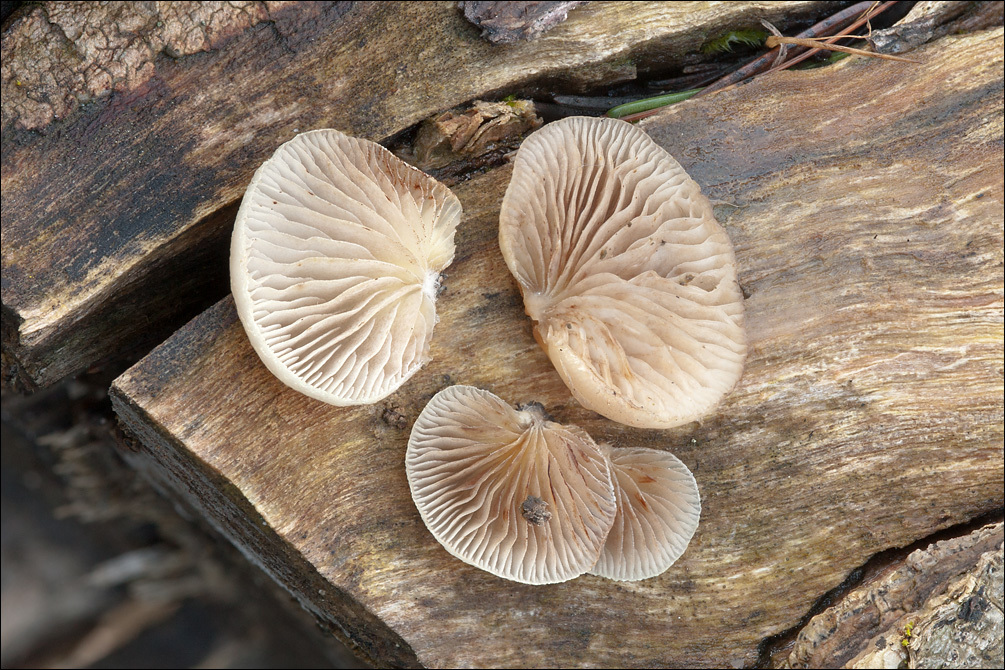
Slo.: zdrizasta postranica - Habitat: alpine valley, river bank, locally almost flat terrain, calcareous ground, river bank vegetation mostly consisting of Salix eleagnos, Picea abies and some Fagus sylvatica; humid air and ground, partly sunny, exposed to direct rain; average precipitations ~ 3.000 mm/year, a average temperature 8-10 deg C, elevation 525 m (1.720 feet), alpine phytogeographical region. - Substratum: dead wood, stump of a cut down Salix eleagnos. - Comments: Growing in a group of five pilei; pilei small or still young; pilei across 0.9 - 2 cm, maximally 7 mm thick; pilei with gelatinous cutis easily peeling off, very sticky; stipe absent, some white mycelium present at the point of attachment; taste mild, indistinctive, smell none; flesh soft, plyant, watery; SP abundant, neutral brown, oac783. I follow taxonomy given in Krieglsteiner (2001) who distinguishes two varieties of Crepidotus mollis, var. mollis and var. calolepsis. The latter on has scales on its pileus (which was not the case in my find) and is considered by some authors as a separate species. - Spores smooth. Spore dimensions: 7.3 [8.1 ; 8.5] 9.4 x 4.9 [5.3 ; 5.5] 5.8 microns; Q = 1.4 [1.5 ; 1.6] 1.7; N = 35; C = 95%; Me = 8.3 x 5.4 microns; Qe = 1.5. Basidia dimensions: 17.3 [22.5 ; 26.1] 31.3 x 6.1 [6.9 ; 7.4] 8.2 microns; Q = 2.5 [3.2 ; 3.6] 4.3; N = 15; C = 95%; Me = 24.3 x 7.2 microns; Qe = 3.4. Cheilocystidia cylindrical to slenderly lageniform. Dimensions: 37.9 [44 ; 51.5] 57.7 x 4.7 [6.3 ; 8.2] 9.7 microns; Q = 5.3 [6.2 ; 7.3] 8.2; N = 7; C = 95%; Me = 47.8 x 7.2 microns; Qe = 6.7. Olympus CH20, NEA 100x/1.25, magnification 1.000 x, oil (spores); NEA 40x/0.65, magnification 400x (all other pictures) in water, all live material. AmScope MA500 digital camera. - Herbarium: Mycotheca and lichen herbarium (LJU-Li) of Slovenian Forestry Institute, Vena pot 2, Ljubljana, Index Herbariorum LJF - Ref.: (1) J. Breitenbach, F. Kraenzlin, Eds., Fungi of Switzerland, Vol.5. Verlag Mykologia (2000), p 300. (2) S. Buczacki, Collins Fungi Guide, Collins (2012), p 390. (3) R. Phillips, Mushrooms, Macmillan (2006), p 269. (4) G.J. Krieglsteiner (Hrsg.), Die Grosspilze Baden-Wrttembergs, Band 4., Ulmer (2001), p 434.
-

Slo.: zdrizasta postranica - Habitat: alpine valley, river bank, locally almost flat terrain, calcareous ground, river bank vegetation mostly consisting of Salix eleagnos, Picea abies and some Fagus sylvatica; humid air and ground, partly sunny, exposed to direct rain; average precipitations ~ 3.000 mm/year, a average temperature 8-10 deg C, elevation 525 m (1.720 feet), alpine phytogeographical region. - Substratum: dead wood, stump of a cut down Salix eleagnos. - Comments: Growing in a group of five pilei; pilei small or still young; pilei across 0.9 - 2 cm, maximally 7 mm thick; pilei with gelatinous cutis easily peeling off, very sticky; stipe absent, some white mycelium present at the point of attachment; taste mild, indistinctive, smell none; flesh soft, plyant, watery; SP abundant, neutral brown, oac783. I follow taxonomy given in Krieglsteiner (2001) who distinguishes two varieties of Crepidotus mollis, var. mollis and var. calolepsis. The latter on has scales on its pileus (which was not the case in my find) and is considered by some authors as a separate species. - Spores smooth. Spore dimensions: 7.3 [8.1 ; 8.5] 9.4 x 4.9 [5.3 ; 5.5] 5.8 microns; Q = 1.4 [1.5 ; 1.6] 1.7; N = 35; C = 95%; Me = 8.3 x 5.4 microns; Qe = 1.5. Basidia dimensions: 17.3 [22.5 ; 26.1] 31.3 x 6.1 [6.9 ; 7.4] 8.2 microns; Q = 2.5 [3.2 ; 3.6] 4.3; N = 15; C = 95%; Me = 24.3 x 7.2 microns; Qe = 3.4. Cheilocystidia cylindrical to slenderly lageniform. Dimensions: 37.9 [44 ; 51.5] 57.7 x 4.7 [6.3 ; 8.2] 9.7 microns; Q = 5.3 [6.2 ; 7.3] 8.2; N = 7; C = 95%; Me = 47.8 x 7.2 microns; Qe = 6.7. Olympus CH20, NEA 100x/1.25, magnification 1.000 x, oil (spores); NEA 40x/0.65, magnification 400x (all other pictures) in water, all live material. AmScope MA500 digital camera. - Herbarium: Mycotheca and lichen herbarium (LJU-Li) of Slovenian Forestry Institute, Vena pot 2, Ljubljana, Index Herbariorum LJF - Ref.: (1) J. Breitenbach, F. Kraenzlin, Eds., Fungi of Switzerland, Vol.5. Verlag Mykologia (2000), p 300. (2) S. Buczacki, Collins Fungi Guide, Collins (2012), p 390. (3) R. Phillips, Mushrooms, Macmillan (2006), p 269. (4) G.J. Krieglsteiner (Hrsg.), Die Grosspilze Baden-Wrttembergs, Band 4., Ulmer (2001), p 434.
-
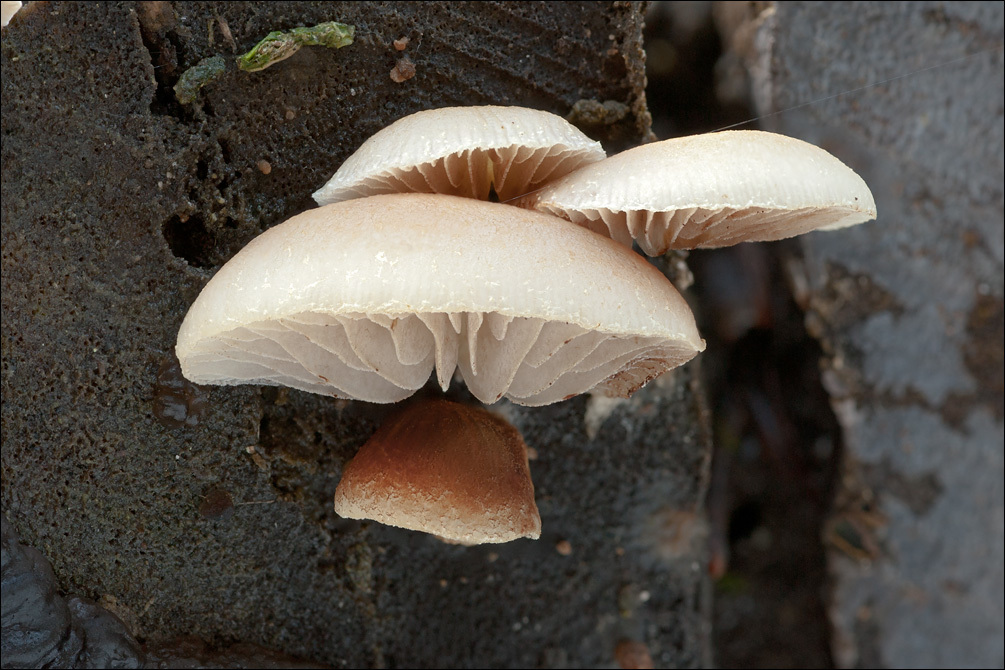
Slo.: zdrizasta postranica - Habitat: alpine valley, river bank, locally almost flat terrain, calcareous ground, river bank vegetation mostly consisting of Salix eleagnos, Picea abies and some Fagus sylvatica; humid air and ground, partly sunny, exposed to direct rain; average precipitations ~ 3.000 mm/year, a average temperature 8-10 deg C, elevation 525 m (1.720 feet), alpine phytogeographical region. - Substratum: dead wood, stump of a cut down Salix eleagnos. - Comments: Growing in a group of five pilei; pilei small or still young; pilei across 0.9 - 2 cm, maximally 7 mm thick; pilei with gelatinous cutis easily peeling off, very sticky; stipe absent, some white mycelium present at the point of attachment; taste mild, indistinctive, smell none; flesh soft, plyant, watery; SP abundant, neutral brown, oac783. I follow taxonomy given in Krieglsteiner (2001) who distinguishes two varieties of Crepidotus mollis, var. mollis and var. calolepsis. The latter on has scales on its pileus (which was not the case in my find) and is considered by some authors as a separate species. - Spores smooth. Spore dimensions: 7.3 [8.1 ; 8.5] 9.4 x 4.9 [5.3 ; 5.5] 5.8 microns; Q = 1.4 [1.5 ; 1.6] 1.7; N = 35; C = 95%; Me = 8.3 x 5.4 microns; Qe = 1.5. Basidia dimensions: 17.3 [22.5 ; 26.1] 31.3 x 6.1 [6.9 ; 7.4] 8.2 microns; Q = 2.5 [3.2 ; 3.6] 4.3; N = 15; C = 95%; Me = 24.3 x 7.2 microns; Qe = 3.4. Cheilocystidia cylindrical to slenderly lageniform. Dimensions: 37.9 [44 ; 51.5] 57.7 x 4.7 [6.3 ; 8.2] 9.7 microns; Q = 5.3 [6.2 ; 7.3] 8.2; N = 7; C = 95%; Me = 47.8 x 7.2 microns; Qe = 6.7. Olympus CH20, NEA 100x/1.25, magnification 1.000 x, oil (spores); NEA 40x/0.65, magnification 400x (all other pictures) in water, all live material. AmScope MA500 digital camera. - Herbarium: Mycotheca and lichen herbarium (LJU-Li) of Slovenian Forestry Institute, Vena pot 2, Ljubljana, Index Herbariorum LJF - Ref.: (1) J. Breitenbach, F. Kraenzlin, Eds., Fungi of Switzerland, Vol.5. Verlag Mykologia (2000), p 300. (2) S. Buczacki, Collins Fungi Guide, Collins (2012), p 390. (3) R. Phillips, Mushrooms, Macmillan (2006), p 269. (4) G.J. Krieglsteiner (Hrsg.), Die Grosspilze Baden-Wrttembergs, Band 4., Ulmer (2001), p 434.
-
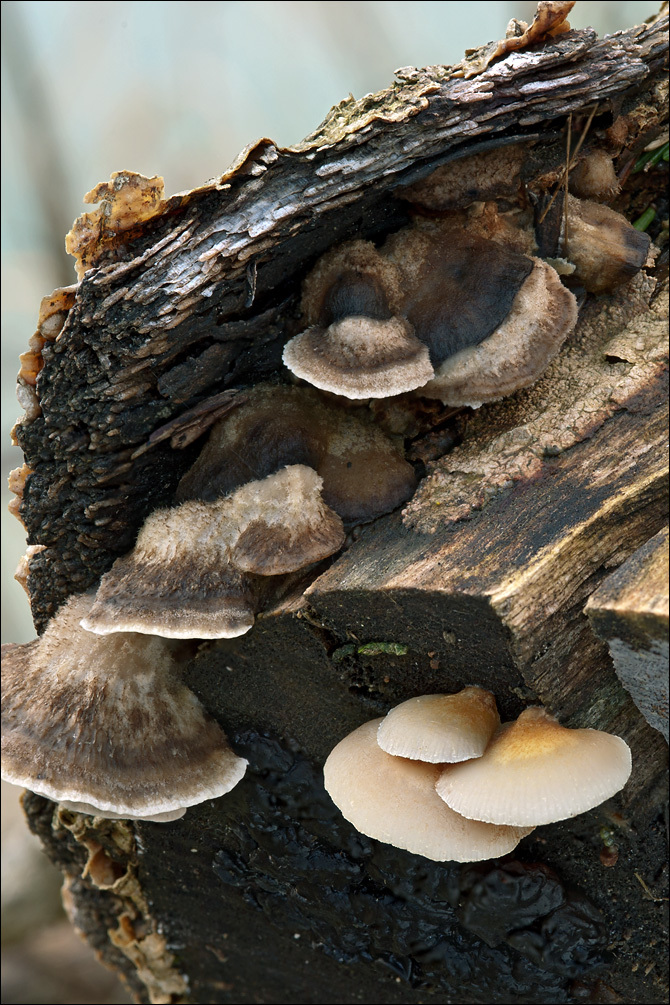
Slo.: zdrizasta postranica - Habitat: alpine valley, river bank, locally almost flat terrain, calcareous ground, river bank vegetation mostly consisting of Salix eleagnos, Picea abies and some Fagus sylvatica; humid air and ground, partly sunny, exposed to direct rain; average precipitations ~ 3.000 mm/year, a average temperature 8-10 deg C, elevation 525 m (1.720 feet), alpine phytogeographical region. - Substratum: dead wood, stump of a cut down Salix eleagnos. - Comments: Growing in a group of five pilei; pilei small or still young; pilei across 0.9 - 2 cm, maximally 7 mm thick; pilei with gelatinous cutis easily peeling off, very sticky; stipe absent, some white mycelium present at the point of attachment; taste mild, indistinctive, smell none; flesh soft, plyant, watery; SP abundant, neutral brown, oac783. I follow taxonomy given in Krieglsteiner (2001) who distinguishes two varieties of Crepidotus mollis, var. mollis and var. calolepsis. The latter on has scales on its pileus (which was not the case in my find) and is considered by some authors as a separate species. - Spores smooth. Spore dimensions: 7.3 [8.1 ; 8.5] 9.4 x 4.9 [5.3 ; 5.5] 5.8 microns; Q = 1.4 [1.5 ; 1.6] 1.7; N = 35; C = 95%; Me = 8.3 x 5.4 microns; Qe = 1.5. Basidia dimensions: 17.3 [22.5 ; 26.1] 31.3 x 6.1 [6.9 ; 7.4] 8.2 microns; Q = 2.5 [3.2 ; 3.6] 4.3; N = 15; C = 95%; Me = 24.3 x 7.2 microns; Qe = 3.4. Cheilocystidia cylindrical to slenderly lageniform. Dimensions: 37.9 [44 ; 51.5] 57.7 x 4.7 [6.3 ; 8.2] 9.7 microns; Q = 5.3 [6.2 ; 7.3] 8.2; N = 7; C = 95%; Me = 47.8 x 7.2 microns; Qe = 6.7. Olympus CH20, NEA 100x/1.25, magnification 1.000 x, oil (spores); NEA 40x/0.65, magnification 400x (all other pictures) in water, all live material. AmScope MA500 digital camera. - Herbarium: Mycotheca and lichen herbarium (LJU-Li) of Slovenian Forestry Institute, Vena pot 2, Ljubljana, Index Herbariorum LJF - Ref.: (1) J. Breitenbach, F. Kraenzlin, Eds., Fungi of Switzerland, Vol.5. Verlag Mykologia (2000), p 300. (2) S. Buczacki, Collins Fungi Guide, Collins (2012), p 390. (3) R. Phillips, Mushrooms, Macmillan (2006), p 269. (4) G.J. Krieglsteiner (Hrsg.), Die Grosspilze Baden-Wrttembergs, Band 4., Ulmer (2001), p 434.
-
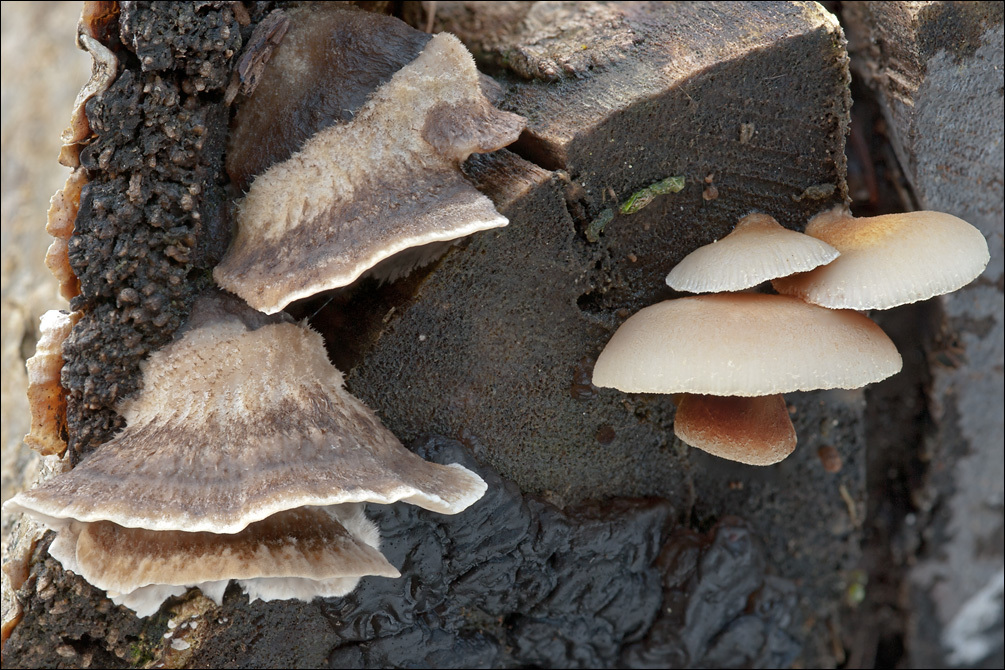
Slo.: zdrizasta postranica - Habitat: alpine valley, river bank, locally almost flat terrain, calcareous ground, river bank vegetation mostly consisting of Salix eleagnos, Picea abies and some Fagus sylvatica; humid air and ground, partly sunny, exposed to direct rain; average precipitations ~ 3.000 mm/year, a average temperature 8-10 deg C, elevation 525 m (1.720 feet), alpine phytogeographical region. - Substratum: dead wood, stump of a cut down Salix eleagnos. - Comments: Growing in a group of five pilei; pilei small or still young; pilei across 0.9 - 2 cm, maximally 7 mm thick; pilei with gelatinous cutis easily peeling off, very sticky; stipe absent, some white mycelium present at the point of attachment; taste mild, indistinctive, smell none; flesh soft, plyant, watery; SP abundant, neutral brown, oac783. I follow taxonomy given in Krieglsteiner (2001) who distinguishes two varieties of Crepidotus mollis, var. mollis and var. calolepsis. The latter on has scales on its pileus (which was not the case in my find) and is considered by some authors as a separate species. - Spores smooth. Spore dimensions: 7.3 [8.1 ; 8.5] 9.4 x 4.9 [5.3 ; 5.5] 5.8 microns; Q = 1.4 [1.5 ; 1.6] 1.7; N = 35; C = 95%; Me = 8.3 x 5.4 microns; Qe = 1.5. Basidia dimensions: 17.3 [22.5 ; 26.1] 31.3 x 6.1 [6.9 ; 7.4] 8.2 microns; Q = 2.5 [3.2 ; 3.6] 4.3; N = 15; C = 95%; Me = 24.3 x 7.2 microns; Qe = 3.4. Cheilocystidia cylindrical to slenderly lageniform. Dimensions: 37.9 [44 ; 51.5] 57.7 x 4.7 [6.3 ; 8.2] 9.7 microns; Q = 5.3 [6.2 ; 7.3] 8.2; N = 7; C = 95%; Me = 47.8 x 7.2 microns; Qe = 6.7. Olympus CH20, NEA 100x/1.25, magnification 1.000 x, oil (spores); NEA 40x/0.65, magnification 400x (all other pictures) in water, all live material. AmScope MA500 digital camera. - Herbarium: Mycotheca and lichen herbarium (LJU-Li) of Slovenian Forestry Institute, Vena pot 2, Ljubljana, Index Herbariorum LJF - Ref.: (1) J. Breitenbach, F. Kraenzlin, Eds., Fungi of Switzerland, Vol.5. Verlag Mykologia (2000), p 300. (2) S. Buczacki, Collins Fungi Guide, Collins (2012), p 390. (3) R. Phillips, Mushrooms, Macmillan (2006), p 269. (4) G.J. Krieglsteiner (Hrsg.), Die Grosspilze Baden-Wrttembergs, Band 4., Ulmer (2001), p 434.
-

Slo.: zdrizasta postranica - Habitat: alpine valley, river bank, locally almost flat terrain, calcareous ground, river bank vegetation mostly consisting of Salix eleagnos, Picea abies and some Fagus sylvatica; humid air and ground, partly sunny, exposed to direct rain; average precipitations ~ 3.000 mm/year, a average temperature 8-10 deg C, elevation 525 m (1.720 feet), alpine phytogeographical region. - Substratum: dead wood, stump of a cut down Salix eleagnos. - Comments: Growing in a group of five pilei; pilei small or still young; pilei across 0.9 - 2 cm, maximally 7 mm thick; pilei with gelatinous cutis easily peeling off, very sticky; stipe absent, some white mycelium present at the point of attachment; taste mild, indistinctive, smell none; flesh soft, plyant, watery; SP abundant, neutral brown, oac783. I follow taxonomy given in Krieglsteiner (2001) who distinguishes two varieties of Crepidotus mollis, var. mollis and var. calolepsis. The latter on has scales on its pileus (which was not the case in my find) and is considered by some authors as a separate species. - Spores smooth. Spore dimensions: 7.3 [8.1 ; 8.5] 9.4 x 4.9 [5.3 ; 5.5] 5.8 microns; Q = 1.4 [1.5 ; 1.6] 1.7; N = 35; C = 95%; Me = 8.3 x 5.4 microns; Qe = 1.5. Basidia dimensions: 17.3 [22.5 ; 26.1] 31.3 x 6.1 [6.9 ; 7.4] 8.2 microns; Q = 2.5 [3.2 ; 3.6] 4.3; N = 15; C = 95%; Me = 24.3 x 7.2 microns; Qe = 3.4. Cheilocystidia cylindrical to slenderly lageniform. Dimensions: 37.9 [44 ; 51.5] 57.7 x 4.7 [6.3 ; 8.2] 9.7 microns; Q = 5.3 [6.2 ; 7.3] 8.2; N = 7; C = 95%; Me = 47.8 x 7.2 microns; Qe = 6.7. Olympus CH20, NEA 100x/1.25, magnification 1.000 x, oil (spores); NEA 40x/0.65, magnification 400x (all other pictures) in water, all live material. AmScope MA500 digital camera. - Herbarium: Mycotheca and lichen herbarium (LJU-Li) of Slovenian Forestry Institute, Vena pot 2, Ljubljana, Index Herbariorum LJF - Ref.: (1) J. Breitenbach, F. Kraenzlin, Eds., Fungi of Switzerland, Vol.5. Verlag Mykologia (2000), p 300. (2) S. Buczacki, Collins Fungi Guide, Collins (2012), p 390. (3) R. Phillips, Mushrooms, Macmillan (2006), p 269. (4) G.J. Krieglsteiner (Hrsg.), Die Grosspilze Baden-Wrttembergs, Band 4., Ulmer (2001), p 434.
-
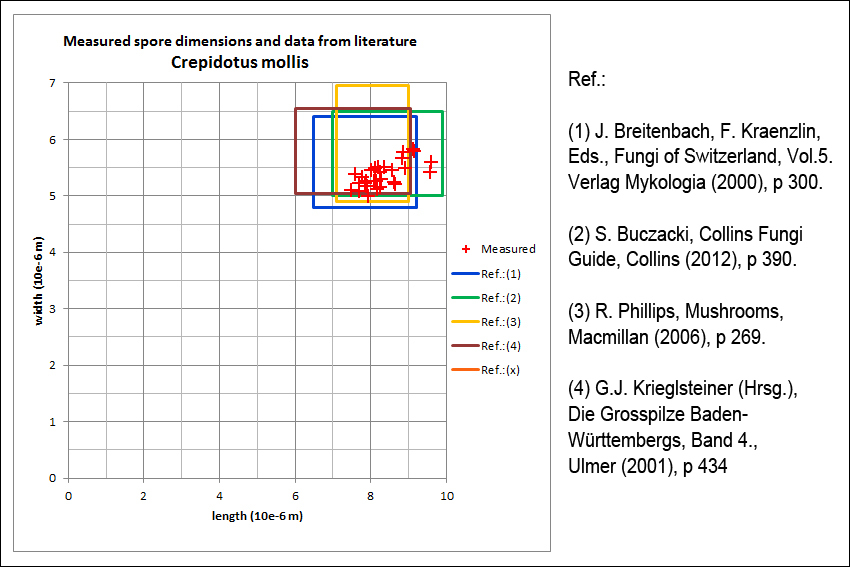
Slo.: zdrizasta postranica - Habitat: alpine valley, river bank, locally almost flat terrain, calcareous ground, river bank vegetation mostly consisting of Salix eleagnos, Picea abies and some Fagus sylvatica; humid air and ground, partly sunny, exposed to direct rain; average precipitations ~ 3.000 mm/year, a average temperature 8-10 deg C, elevation 525 m (1.720 feet), alpine phytogeographical region. - Substratum: dead wood, stump of a cut down Salix eleagnos. - Comments: Growing in a group of five pilei; pilei small or still young; pilei across 0.9 - 2 cm, maximally 7 mm thick; pilei with gelatinous cutis easily peeling off, very sticky; stipe absent, some white mycelium present at the point of attachment; taste mild, indistinctive, smell none; flesh soft, plyant, watery; SP abundant, neutral brown, oac783. I follow taxonomy given in Krieglsteiner (2001) who distinguishes two varieties of Crepidotus mollis, var. mollis and var. calolepsis. The latter on has scales on its pileus (which was not the case in my find) and is considered by some authors as a separate species. - Spores smooth. Spore dimensions: 7.3 [8.1 ; 8.5] 9.4 x 4.9 [5.3 ; 5.5] 5.8 microns; Q = 1.4 [1.5 ; 1.6] 1.7; N = 35; C = 95%; Me = 8.3 x 5.4 microns; Qe = 1.5. Basidia dimensions: 17.3 [22.5 ; 26.1] 31.3 x 6.1 [6.9 ; 7.4] 8.2 microns; Q = 2.5 [3.2 ; 3.6] 4.3; N = 15; C = 95%; Me = 24.3 x 7.2 microns; Qe = 3.4. Cheilocystidia cylindrical to slenderly lageniform. Dimensions: 37.9 [44 ; 51.5] 57.7 x 4.7 [6.3 ; 8.2] 9.7 microns; Q = 5.3 [6.2 ; 7.3] 8.2; N = 7; C = 95%; Me = 47.8 x 7.2 microns; Qe = 6.7. Olympus CH20, NEA 100x/1.25, magnification 1.000 x, oil (spores); NEA 40x/0.65, magnification 400x (all other pictures) in water, all live material. AmScope MA500 digital camera. - Herbarium: Mycotheca and lichen herbarium (LJU-Li) of Slovenian Forestry Institute, Vena pot 2, Ljubljana, Index Herbariorum LJF - Ref.: (1) J. Breitenbach, F. Kraenzlin, Eds., Fungi of Switzerland, Vol.5. Verlag Mykologia (2000), p 300. (2) S. Buczacki, Collins Fungi Guide, Collins (2012), p 390. (3) R. Phillips, Mushrooms, Macmillan (2006), p 269. (4) G.J. Krieglsteiner (Hrsg.), Die Grosspilze Baden-Wrttembergs, Band 4., Ulmer (2001), p 434.
-

Slo.: zdrizasta postranica - Simple septa of hyphae. - Habitat: alpine valley, river bank, locally almost flat terrain, calcareous ground, river bank vegetation mostly consisting of Salix eleagnos, Picea abies and some Fagus sylvatica; humid air and ground, partly sunny, exposed to direct rain; average precipitations ~ 3.000 mm/year, a average temperature 8-10 deg C, elevation 525 m (1.720 feet), alpine phytogeographical region. - Substratum: dead wood, stump of a cut down Salix eleagnos. - Comments: Growing in a group of five pilei; pilei small or still young; pilei across 0.9 - 2 cm, maximally 7 mm thick; pilei with gelatinous cutis easily peeling off, very sticky; stipe absent, some white mycelium present at the point of attachment; taste mild, indistinctive, smell none; flesh soft, plyant, watery; SP abundant, neutral brown, oac783. I follow taxonomy given in Krieglsteiner (2001) who distinguishes two varieties of Crepidotus mollis, var. mollis and var. calolepsis. The latter on has scales on its pileus (which was not the case in my find) and is considered by some authors as a separate species. - Spores smooth. Spore dimensions: 7.3 [8.1 ; 8.5] 9.4 x 4.9 [5.3 ; 5.5] 5.8 microns; Q = 1.4 [1.5 ; 1.6] 1.7; N = 35; C = 95%; Me = 8.3 x 5.4 microns; Qe = 1.5. Basidia dimensions: 17.3 [22.5 ; 26.1] 31.3 x 6.1 [6.9 ; 7.4] 8.2 microns; Q = 2.5 [3.2 ; 3.6] 4.3; N = 15; C = 95%; Me = 24.3 x 7.2 microns; Qe = 3.4. Cheilocystidia cylindrical to slenderly lageniform. Dimensions: 37.9 [44 ; 51.5] 57.7 x 4.7 [6.3 ; 8.2] 9.7 microns; Q = 5.3 [6.2 ; 7.3] 8.2; N = 7; C = 95%; Me = 47.8 x 7.2 microns; Qe = 6.7. Olympus CH20, NEA 100x/1.25, magnification 1.000 x, oil (spores); NEA 40x/0.65, magnification 400x (all other pictures) in water, all live material. AmScope MA500 digital camera. - Herbarium: Mycotheca and lichen herbarium (LJU-Li) of Slovenian Forestry Institute, Vena pot 2, Ljubljana, Index Herbariorum LJF - Ref.: (1) J. Breitenbach, F. Kraenzlin, Eds., Fungi of Switzerland, Vol.5. Verlag Mykologia (2000), p 300. (2) S. Buczacki, Collins Fungi Guide, Collins (2012), p 390. (3) R. Phillips, Mushrooms, Macmillan (2006), p 269. (4) G.J. Krieglsteiner (Hrsg.), Die Grosspilze Baden-Wrttembergs, Band 4., Ulmer (2001), p 434.
-
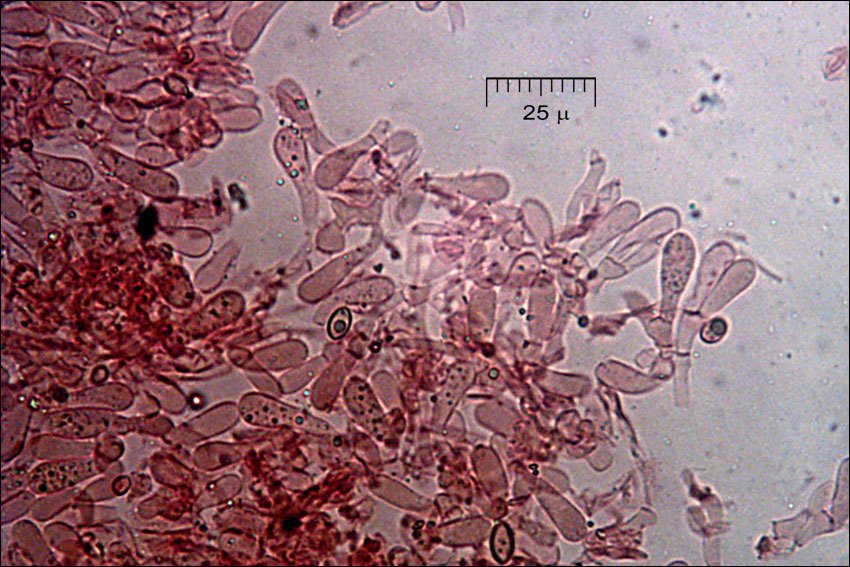
Slo.: zdrizasta postranica - Basidia. - Habitat: alpine valley, river bank, locally almost flat terrain, calcareous ground, river bank vegetation mostly consisting of Salix eleagnos, Picea abies and some Fagus sylvatica; humid air and ground, partly sunny, exposed to direct rain; average precipitations ~ 3.000 mm/year, a average temperature 8-10 deg C, elevation 525 m (1.720 feet), alpine phytogeographical region. - Substratum: dead wood, stump of a cut down Salix eleagnos. - Comments: Growing in a group of five pilei; pilei small or still young; pilei across 0.9 - 2 cm, maximally 7 mm thick; pilei with gelatinous cutis easily peeling off, very sticky; stipe absent, some white mycelium present at the point of attachment; taste mild, indistinctive, smell none; flesh soft, plyant, watery; SP abundant, neutral brown, oac783. I follow taxonomy given in Krieglsteiner (2001) who distinguishes two varieties of Crepidotus mollis, var. mollis and var. calolepsis. The latter on has scales on its pileus (which was not the case in my find) and is considered by some authors as a separate species. - Spores smooth. Spore dimensions: 7.3 [8.1 ; 8.5] 9.4 x 4.9 [5.3 ; 5.5] 5.8 microns; Q = 1.4 [1.5 ; 1.6] 1.7; N = 35; C = 95%; Me = 8.3 x 5.4 microns; Qe = 1.5. Basidia dimensions: 17.3 [22.5 ; 26.1] 31.3 x 6.1 [6.9 ; 7.4] 8.2 microns; Q = 2.5 [3.2 ; 3.6] 4.3; N = 15; C = 95%; Me = 24.3 x 7.2 microns; Qe = 3.4. Cheilocystidia cylindrical to slenderly lageniform. Dimensions: 37.9 [44 ; 51.5] 57.7 x 4.7 [6.3 ; 8.2] 9.7 microns; Q = 5.3 [6.2 ; 7.3] 8.2; N = 7; C = 95%; Me = 47.8 x 7.2 microns; Qe = 6.7. Olympus CH20, NEA 100x/1.25, magnification 1.000 x, oil (spores); NEA 40x/0.65, magnification 400x (all other pictures) in water, all live material. AmScope MA500 digital camera. - Herbarium: Mycotheca and lichen herbarium (LJU-Li) of Slovenian Forestry Institute, Vena pot 2, Ljubljana, Index Herbariorum LJF - Ref.: (1) J. Breitenbach, F. Kraenzlin, Eds., Fungi of Switzerland, Vol.5. Verlag Mykologia (2000), p 300. (2) S. Buczacki, Collins Fungi Guide, Collins (2012), p 390. (3) R. Phillips, Mushrooms, Macmillan (2006), p 269. (4) G.J. Krieglsteiner (Hrsg.), Die Grosspilze Baden-Wrttembergs, Band 4., Ulmer (2001), p 434.
-
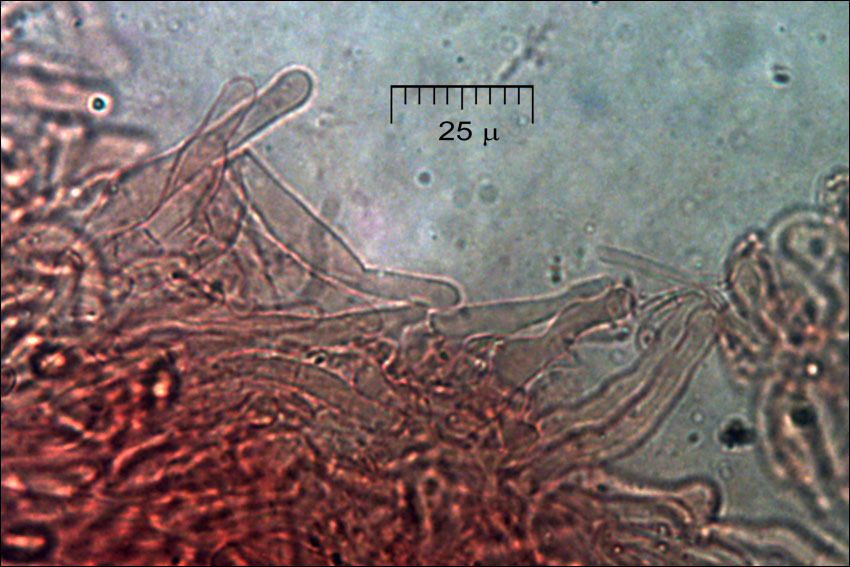
Slo.: zdrizasta postranica - Cheilocystidia. - Habitat: alpine valley, river bank, locally almost flat terrain, calcareous ground, river bank vegetation mostly consisting of Salix eleagnos, Picea abies and some Fagus sylvatica; humid air and ground, partly sunny, exposed to direct rain; average precipitations ~ 3.000 mm/year, a average temperature 8-10 deg C, elevation 525 m (1.720 feet), alpine phytogeographical region. - Substratum: dead wood, stump of a cut down Salix eleagnos. - Comments: Growing in a group of five pilei; pilei small or still young; pilei across 0.9 - 2 cm, maximally 7 mm thick; pilei with gelatinous cutis easily peeling off, very sticky; stipe absent, some white mycelium present at the point of attachment; taste mild, indistinctive, smell none; flesh soft, plyant, watery; SP abundant, neutral brown, oac783. I follow taxonomy given in Krieglsteiner (2001) who distinguishes two varieties of Crepidotus mollis, var. mollis and var. calolepsis. The latter on has scales on its pileus (which was not the case in my find) and is considered by some authors as a separate species. - Spores smooth. Spore dimensions: 7.3 [8.1 ; 8.5] 9.4 x 4.9 [5.3 ; 5.5] 5.8 microns; Q = 1.4 [1.5 ; 1.6] 1.7; N = 35; C = 95%; Me = 8.3 x 5.4 microns; Qe = 1.5. Basidia dimensions: 17.3 [22.5 ; 26.1] 31.3 x 6.1 [6.9 ; 7.4] 8.2 microns; Q = 2.5 [3.2 ; 3.6] 4.3; N = 15; C = 95%; Me = 24.3 x 7.2 microns; Qe = 3.4. Cheilocystidia cylindrical to slenderly lageniform. Dimensions: 37.9 [44 ; 51.5] 57.7 x 4.7 [6.3 ; 8.2] 9.7 microns; Q = 5.3 [6.2 ; 7.3] 8.2; N = 7; C = 95%; Me = 47.8 x 7.2 microns; Qe = 6.7. Olympus CH20, NEA 100x/1.25, magnification 1.000 x, oil (spores); NEA 40x/0.65, magnification 400x (all other pictures) in water, all live material. AmScope MA500 digital camera. - Herbarium: Mycotheca and lichen herbarium (LJU-Li) of Slovenian Forestry Institute, Vena pot 2, Ljubljana, Index Herbariorum LJF - Ref.: (1) J. Breitenbach, F. Kraenzlin, Eds., Fungi of Switzerland, Vol.5. Verlag Mykologia (2000), p 300. (2) S. Buczacki, Collins Fungi Guide, Collins (2012), p 390. (3) R. Phillips, Mushrooms, Macmillan (2006), p 269. (4) G.J. Krieglsteiner (Hrsg.), Die Grosspilze Baden-Wrttembergs, Band 4., Ulmer (2001), p 434.
-
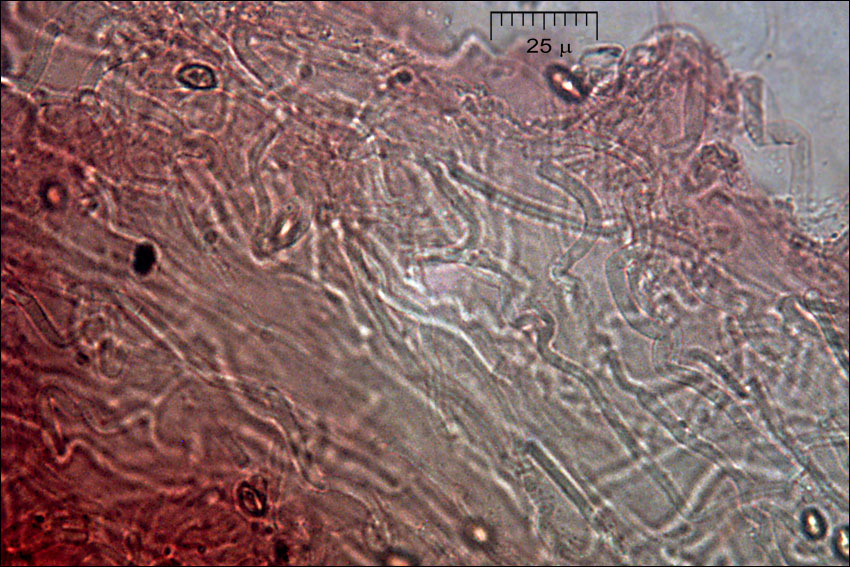
Slo.: zdrizasta postranica - Gelatinized pileipelis. - Habitat: alpine valley, river bank, locally almost flat terrain, calcareous ground, river bank vegetation mostly consisting of Salix eleagnos, Picea abies and some Fagus sylvatica; humid air and ground, partly sunny, exposed to direct rain; average precipitations ~ 3.000 mm/year, a average temperature 8-10 deg C, elevation 525 m (1.720 feet), alpine phytogeographical region. - Substratum: dead wood, stump of a cut down Salix eleagnos. - Comments: Growing in a group of five pilei; pilei small or still young; pilei across 0.9 - 2 cm, maximally 7 mm thick; pilei with gelatinous cutis easily peeling off, very sticky; stipe absent, some white mycelium present at the point of attachment; taste mild, indistinctive, smell none; flesh soft, plyant, watery; SP abundant, neutral brown, oac783. I follow taxonomy given in Krieglsteiner (2001) who distinguishes two varieties of Crepidotus mollis, var. mollis and var. calolepsis. The latter on has scales on its pileus (which was not the case in my find) and is considered by some authors as a separate species. - Spores smooth. Spore dimensions: 7.3 [8.1 ; 8.5] 9.4 x 4.9 [5.3 ; 5.5] 5.8 microns; Q = 1.4 [1.5 ; 1.6] 1.7; N = 35; C = 95%; Me = 8.3 x 5.4 microns; Qe = 1.5. Basidia dimensions: 17.3 [22.5 ; 26.1] 31.3 x 6.1 [6.9 ; 7.4] 8.2 microns; Q = 2.5 [3.2 ; 3.6] 4.3; N = 15; C = 95%; Me = 24.3 x 7.2 microns; Qe = 3.4. Cheilocystidia cylindrical to slenderly lageniform. Dimensions: 37.9 [44 ; 51.5] 57.7 x 4.7 [6.3 ; 8.2] 9.7 microns; Q = 5.3 [6.2 ; 7.3] 8.2; N = 7; C = 95%; Me = 47.8 x 7.2 microns; Qe = 6.7. Olympus CH20, NEA 100x/1.25, magnification 1.000 x, oil (spores); NEA 40x/0.65, magnification 400x (all other pictures) in water, all live material. AmScope MA500 digital camera. - Herbarium: Mycotheca and lichen herbarium (LJU-Li) of Slovenian Forestry Institute, Vena pot 2, Ljubljana, Index Herbariorum LJF - Ref.: (1) J. Breitenbach, F. Kraenzlin, Eds., Fungi of Switzerland, Vol.5. Verlag Mykologia (2000), p 300. (2) S. Buczacki, Collins Fungi Guide, Collins (2012), p 390. (3) R. Phillips, Mushrooms, Macmillan (2006), p 269. (4) G.J. Krieglsteiner (Hrsg.), Die Grosspilze Baden-Wrttembergs, Band 4., Ulmer (2001), p 434.
-
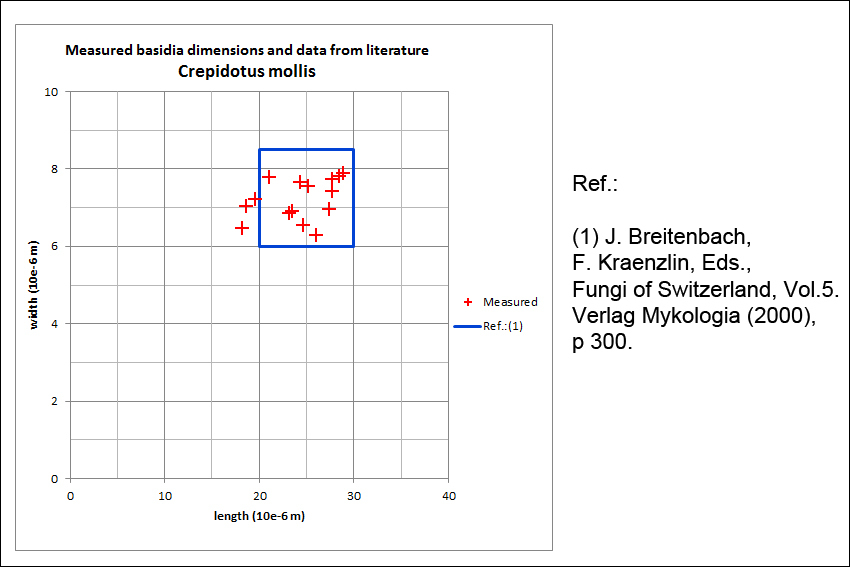
Slo.: zdrizasta postranica - Habitat: alpine valley, river bank, locally almost flat terrain, calcareous ground, river bank vegetation mostly consisting of Salix eleagnos, Picea abies and some Fagus sylvatica; humid air and ground, partly sunny, exposed to direct rain; average precipitations ~ 3.000 mm/year, a average temperature 8-10 deg C, elevation 525 m (1.720 feet), alpine phytogeographical region. - Substratum: dead wood, stump of a cut down Salix eleagnos. - Comments: Growing in a group of five pilei; pilei small or still young; pilei across 0.9 - 2 cm, maximally 7 mm thick; pilei with gelatinous cutis easily peeling off, very sticky; stipe absent, some white mycelium present at the point of attachment; taste mild, indistinctive, smell none; flesh soft, plyant, watery; SP abundant, neutral brown, oac783. I follow taxonomy given in Krieglsteiner (2001) who distinguishes two varieties of Crepidotus mollis, var. mollis and var. calolepsis. The latter on has scales on its pileus (which was not the case in my find) and is considered by some authors as a separate species. - Spores smooth. Spore dimensions: 7.3 [8.1 ; 8.5] 9.4 x 4.9 [5.3 ; 5.5] 5.8 microns; Q = 1.4 [1.5 ; 1.6] 1.7; N = 35; C = 95%; Me = 8.3 x 5.4 microns; Qe = 1.5. Basidia dimensions: 17.3 [22.5 ; 26.1] 31.3 x 6.1 [6.9 ; 7.4] 8.2 microns; Q = 2.5 [3.2 ; 3.6] 4.3; N = 15; C = 95%; Me = 24.3 x 7.2 microns; Qe = 3.4. Cheilocystidia cylindrical to slenderly lageniform. Dimensions: 37.9 [44 ; 51.5] 57.7 x 4.7 [6.3 ; 8.2] 9.7 microns; Q = 5.3 [6.2 ; 7.3] 8.2; N = 7; C = 95%; Me = 47.8 x 7.2 microns; Qe = 6.7. Olympus CH20, NEA 100x/1.25, magnification 1.000 x, oil (spores); NEA 40x/0.65, magnification 400x (all other pictures) in water, all live material. AmScope MA500 digital camera. - Herbarium: Mycotheca and lichen herbarium (LJU-Li) of Slovenian Forestry Institute, Vena pot 2, Ljubljana, Index Herbariorum LJF - Ref.: (1) J. Breitenbach, F. Kraenzlin, Eds., Fungi of Switzerland, Vol.5. Verlag Mykologia (2000), p 300. (2) S. Buczacki, Collins Fungi Guide, Collins (2012), p 390. (3) R. Phillips, Mushrooms, Macmillan (2006), p 269. (4) G.J. Krieglsteiner (Hrsg.), Die Grosspilze Baden-Wrttembergs, Band 4., Ulmer (2001), p 434.
-

Slo.: zdrizasta postranica - Habitat: alpine valley, river bank, locally almost flat terrain, calcareous ground, river bank vegetation mostly consisting of Salix eleagnos, Picea abies and some Fagus sylvatica; humid air and ground, partly sunny, exposed to direct rain; average precipitations ~ 3.000 mm/year, a average temperature 8-10 deg C, elevation 525 m (1.720 feet), alpine phytogeographical region. - Substratum: dead wood, stump of a cut down Salix eleagnos. - Comments: Growing in a group of five pilei; pilei small or still young; pilei across 0.9 - 2 cm, maximally 7 mm thick; pilei with gelatinous cutis easily peeling off, very sticky; stipe absent, some white mycelium present at the point of attachment; taste mild, indistinctive, smell none; flesh soft, plyant, watery; SP abundant, neutral brown, oac783. I follow taxonomy given in Krieglsteiner (2001) who distinguishes two varieties of Crepidotus mollis, var. mollis and var. calolepsis. The latter on has scales on its pileus (which was not the case in my find) and is considered by some authors as a separate species. - Spores smooth. Spore dimensions: 7.3 [8.1 ; 8.5] 9.4 x 4.9 [5.3 ; 5.5] 5.8 microns; Q = 1.4 [1.5 ; 1.6] 1.7; N = 35; C = 95%; Me = 8.3 x 5.4 microns; Qe = 1.5. Basidia dimensions: 17.3 [22.5 ; 26.1] 31.3 x 6.1 [6.9 ; 7.4] 8.2 microns; Q = 2.5 [3.2 ; 3.6] 4.3; N = 15; C = 95%; Me = 24.3 x 7.2 microns; Qe = 3.4. Cheilocystidia cylindrical to slenderly lageniform. Dimensions: 37.9 [44 ; 51.5] 57.7 x 4.7 [6.3 ; 8.2] 9.7 microns; Q = 5.3 [6.2 ; 7.3] 8.2; N = 7; C = 95%; Me = 47.8 x 7.2 microns; Qe = 6.7. Olympus CH20, NEA 100x/1.25, magnification 1.000 x, oil (spores); NEA 40x/0.65, magnification 400x (all other pictures) in water, all live material. AmScope MA500 digital camera. - Herbarium: Mycotheca and lichen herbarium (LJU-Li) of Slovenian Forestry Institute, Vena pot 2, Ljubljana, Index Herbariorum LJF - Ref.: (1) J. Breitenbach, F. Kraenzlin, Eds., Fungi of Switzerland, Vol.5. Verlag Mykologia (2000), p 300. (2) S. Buczacki, Collins Fungi Guide, Collins (2012), p 390. (3) R. Phillips, Mushrooms, Macmillan (2006), p 269. (4) G.J. Krieglsteiner (Hrsg.), Die Grosspilze Baden-Wrttembergs, Band 4., Ulmer (2001), p 434.
-
2001 California Academy of Sciences
CalPhotos
-
2001 California Academy of Sciences
CalPhotos
-
Mushroom Observer Image 1001233: Crepidotus mollis (Schaeff.) Staude
-
Mushroom Observer Image 125723: Crepidotus mollis (Schaeff.) Staude

